Campaign History of the 151e Régiment d'Infanterie - XXIII
~ 1917 ~
Second Battle of Verdun (16 July - 14 September)
In what would be the first of Pétain’s limited offensives following the rebuilding period after the turbulent spring and summer of 1917, the French army would be going back on the attack at Verdun. On the left bank of the Meuse, things had remained a quiet one for the first six months of 1917. But in June 1917, the Germans opened assaults on the southern slopes of Côte 304 and Mort Homme, as well an attack on the fortified towns of Avocourt and Cumières. These prove partially successful and the fighting continues into July. A back and forth of bloody attacks and counter-attacks ensued, lasting until the end of the month. This was the aim of the coming French offensive, to rectify the recent gains made by German forces, re-establishing a tactical advantage that, at the same time, would hold heavy symbolic value. A massive coordinated assault would be launched on both banks of the Meuse along a twenty-five kilometer front. For the execution of the operation, select formations were chosen which had already distinguished themselves in various sectors at Verdun: XIII, XV, XVI, and XXXII Army Corps. Once more, the 151 would be going back to Verdun, its fourth rotation in the Furnace.
15 July: the regiment is told to take preparation to depart its billets at Laimont and Neuville-sur-Orne. At 2000 hrs, 1st and 3rd Bats. (with CHR) embark in trucks. 2nd Bat. remain in place. Divisional records show the effective of the 151 RI was as follows on 5 July 1917: 1 Bat. (25 officers, 850 men), 2 Bat. (15 officers, 650 men), 3 Bat. (15 officers, 650 men), or 2,205 total.
Miribel Barracks in August 1917. A automobile has been tossed onto the roof of the stables by a large artillery shell. Photo taken by Aspirant André L'Huillier.
16 July: 1st and 3rd Bats disembark at Verdun (Faubourg-Pavé) around 0400 hrs, where the units would spend the night in its old barracks, Miribel, the roof and walls now punctured and pocked by shell-fire. At 1900 hrs, the battalions depart the barracks and go to relieve the 8 BCP in the [Bois des] Caurières sector 2.5 km north of Fort Douaumont, specifically the [Ferme de] Chambrettes and Hermitage quarters. This is carried out with incident. The 2nd Bat. board trucks at Laimont to follow the other battalions up into line.
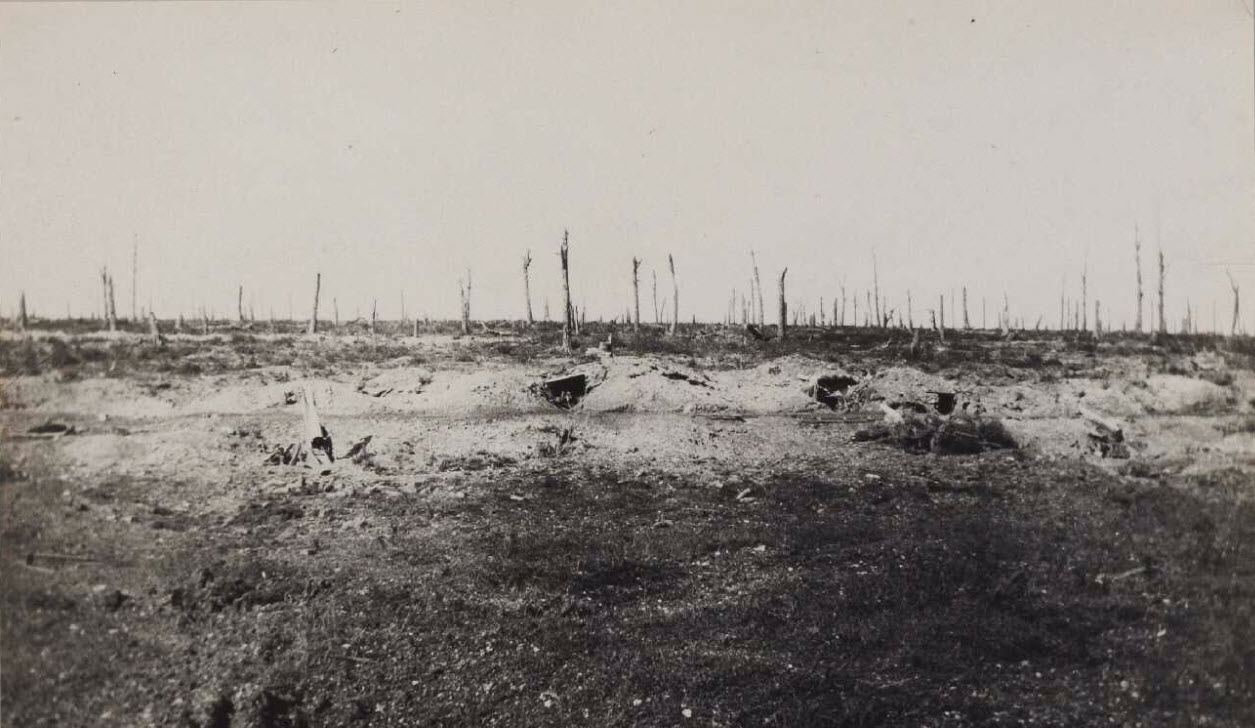
The Bois Hermitage in Sept. 1917. (source: Valois Collection)
17 July: quiet day for the two battalion already in line. The 2nd Bat. arrives at Verdun in the morning and likewise rests at Miribel until the evening. At 1900 hrs it sets off up to the line where it relieves a battalion from the 94 RI.

Left: Map of the right banks in August 1917. Right: Map of the Bois des Caurières--Chambrettes sector July-August 1917. (sources: AFGG and 162 RI JMO -- link to original here)
18 July: After a definitive relief, the Caurières zone (sub-sector Marguerite) is occupied in the following way: 2nd Bat. in Deux Bois quarter having two companies in the first line (5 Co. on the right, 7 Co. on the left), 6 Co. in reserve. The 1st Bat. in Chambrettes quarter having two companies in the first line (1 Co. on the right, 2 Co. on the left, 3 Co. in reserve. 3rd Bat. in Hermitage quarter is in reserve. The day passes quietly, although interrupted by a "Minens" (mortars) duel. At night the Germans conduct a raid on the 1 Co. but are repulsed by grenades. At 1945 hrs, the enemy renews its attempt without success. Losses: 3 wounded, 1 missing.
Ruins of the village of Douaumont, 19 July 1917. Photo taken by Aspirant André L'Huillier.
19-29 July: The Sector is quiet, cut by intermittent but intense salvos of howitzer artillery fire. All units are busy with maintaining the sector and repairing the critical sections of trenches. The next day, the morning and afternoon are quiet. In the evening, the 2nd Bat. sector (on the right) is hit by numerous minens. The Hermitage quarter is bombarded intensely. During the night, salvos of 77s and 105s come down along the entire sector in unpredictable intervals. On 21 July, the sector quiet. During the course of the day, the sector is bombarded from one end to the other.
On 22 July, at 0525 hrs the Germans unleash a bombardment of extreme violence along the entire sector, but principally on the Deux Bois and especially on the front of the regiment to the right (129 RI). After a bombardment of a quarter of an hour, the Germans carry out a raid on the first line of this regiment but make no headway. The rest of the day and night remained quiet. The next day, there's an exchange of rifle-grenades on the first lines. All units remain in place spending all day and night working on the trenches and boyaux, especially in the Chambrettes quarter, which will contain the departure parallels. On 24 July, the day remains quiet day but there's much activity by the artillery of both sides during the night. At night, 3rd Bat. relieves the 1st Bat. without incident in the Chambrettes quarter. The 11 Co. is installed on the left in liaison with the 267 RI, 10 Co. to the right, 9 Co. in support. The 1st Bat. goes into reserve in the Hermitage quarter.
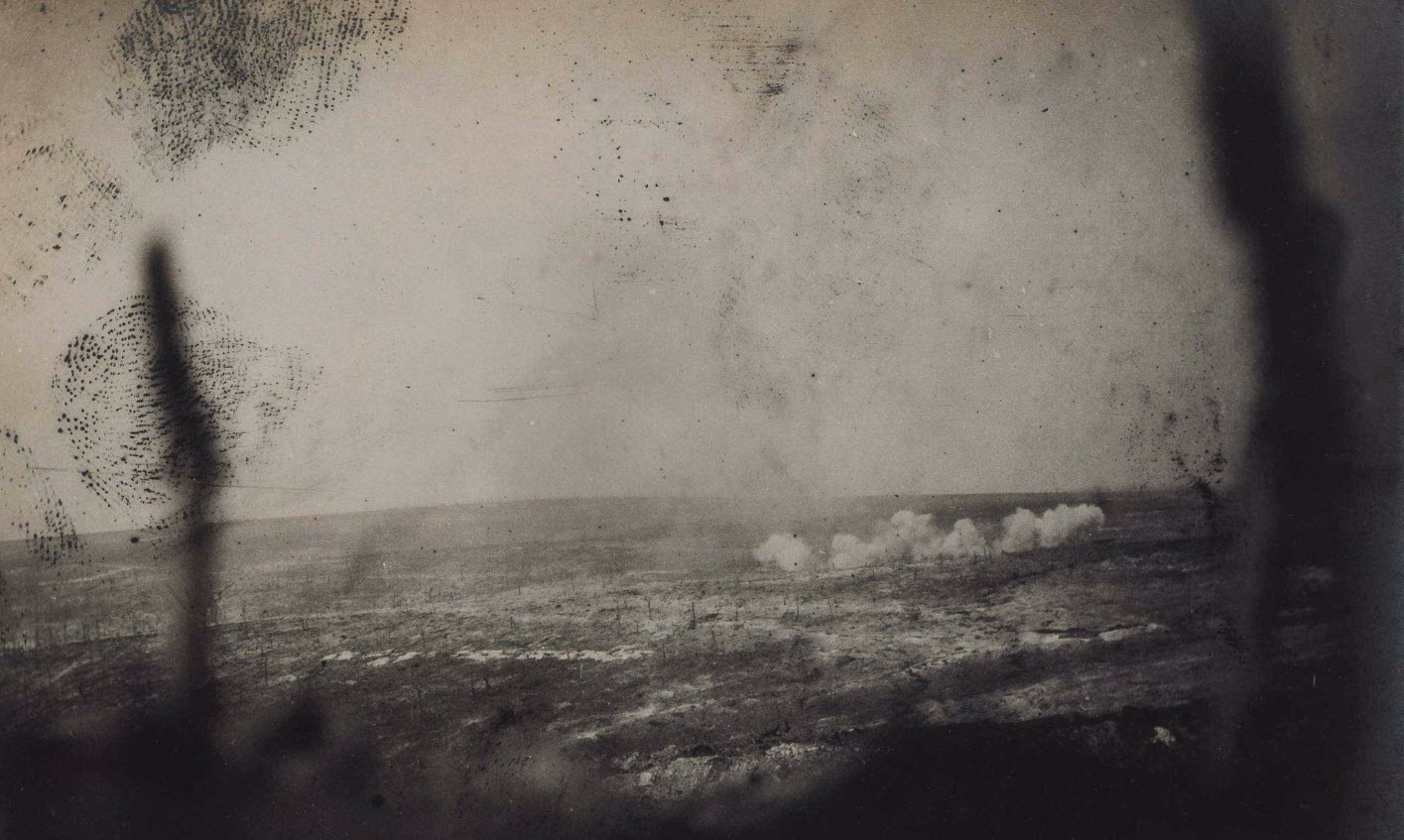
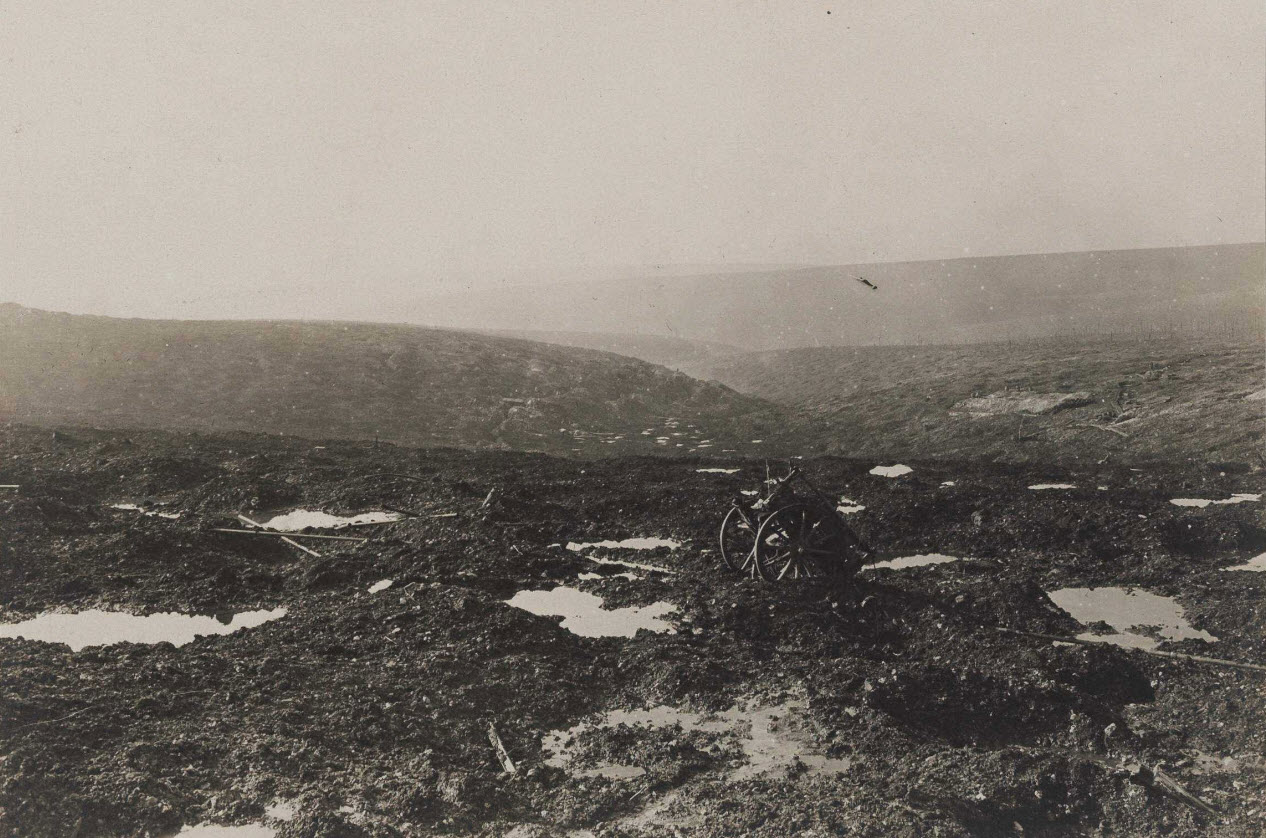

Ferme des Chambrettes sector, Sept. 1917. (source: Valois Collection)
On 25-26 July, repair work on the boyaux is pushed forward, principally the Boyaux Tirailleurs, Mayeure, and Paderborn (Chambrettes quarter). On 27 July, the day starts off quietly then the artillery of both sides becomes highly active, especially the heavy artillery. The next day remains quiet but at 1600 hrs an intense bombardment on the Deux Bois quarter. Transfers: Médecin-aide Major Vincens rejoins the Colonial troops. M. Judet de la Combe, Médecin Major 1st Class arrives from RPS. On July 29, the units remain in the same positions and continue working on the lines.
Transfers: Lieut. Leroux arrives from the general-staff from the V Army assigned as intelligence information. Sous-Lieut. Philippot is returns from convalescence and is assigned to the 9 Co. Sous-Lieut. Delannay arrives from the DD and is assigned to 7 Co.
19 July - 7 wounded.
20 July - 1 wounded.
21 July - 1 killed, 4 wounded.
22 July - 3 killed, 7 wounded, including Lieut. Maillard (mortally wounded).
25 July - 2 wounded.
27 July - 1 killed, 7 wounded.
30 July: in the morning, both sides aviation active. During the night, both sides artillery fairly active on hitting the lines to the rear. At night 1 Bat/162 RI relieves the 2 Bat/151 RI in the Deux Bois quarter, which goes to billet at Haudainville. The 3 Bat/162 RI relieves the 1 Bat/151 RI in the Hermitage, which goes to billet at Camp Driant (west of Belrupt). The relief is carried out without incident.
31 July: the day is quiet. Some rifle-grenades bombard the first line trenches of the 3rd Bat. At night, 3rd Bat. is relieved by 2 Bat/162 RI and does to billet at Camp de la Bouvoir (east of Belrupt). The relief is carried out without incident.
Transfers: Lieut. Pautet arrives from the DD and is assigned to 1 Co. Sous-Lieut. Collinet arrives from the DD and is assigned to the 10 Co.
1-6 August: the battalions rest and bathe, cleaning arms and equipment. From 2-6 August, the men are put to work performing various work and chores around the billets.
Transfers: Capitaine Gelly is detached from the general-staff from Seulis.

Aspirant André L'Huillier with his section (1e Section, 6e Company) on 15 August 1917 at Haudainville.
7-17 August: Even when at rest though, the battalions were put to work transporting heavy loads of munitions and supplies to and from the Forts Souville and St. Michel. Various detachments are sent into line to transport bombs and to work in the sector Caurières. There were even a few days in between the work fatigues where the companies of 2 and 3 Battalions would take shelter in the famous Fort Douaumont. Despite it being under bombardment by the most massive shells, life was fairly comfortable in the protected subterranean galleries of the fort. The same could not be said for the coming and going to carry out the various assignments, during which time the men had to run through the same devastating shell-fire while heavily burdened. In the end, they preferred to avoid the fort altogether. Just before being sent back out to the trenches, L’Huillier (who'd been promoted from aspirant to second lieutenant and transferred to 10 Company) wrote out a short ode:
"To the One-Fifty-One - There's no need to worry.
There are two ways to be, you're at the front or you're not. If you're not, there's no need to worry.
--If you're there, there are two alternatives: you're at rest or you're in the trenches. If you are at rest, there's no need to worry.
--If you're in the trenches, there are two alternatives: you're in reserve or you're in the first-line. If you're in reserve, there's no need to worry.
--If you're in the first-line, there are two alternatives: all hell's breaking loose or all hell's not breaking loose.
--If all hell's not breaking loose, there's no need to worry. If all hell's breaking loose, there are two alternatives: you're wounded or you're not.
--If you're not there's no need to worry. If you are, there are two alternatives: you're wounded gravely or you're not.
--If you're not wounded gravely, there's no need to worry. If you're wounded gravely, there are two alternatives: you survive or you don't survive.
--If you survive, there's no need to worry. If you don't survive and if you've heeded my advice, you'll have never have done so afterall.”
6 August - 1 wounded.
9 August - 3 killed, 3 wounded.
10 August - 1 wounded.
11 August - 1 wounded.
15 August - 1 wounded.
17 August - 1 wounded.
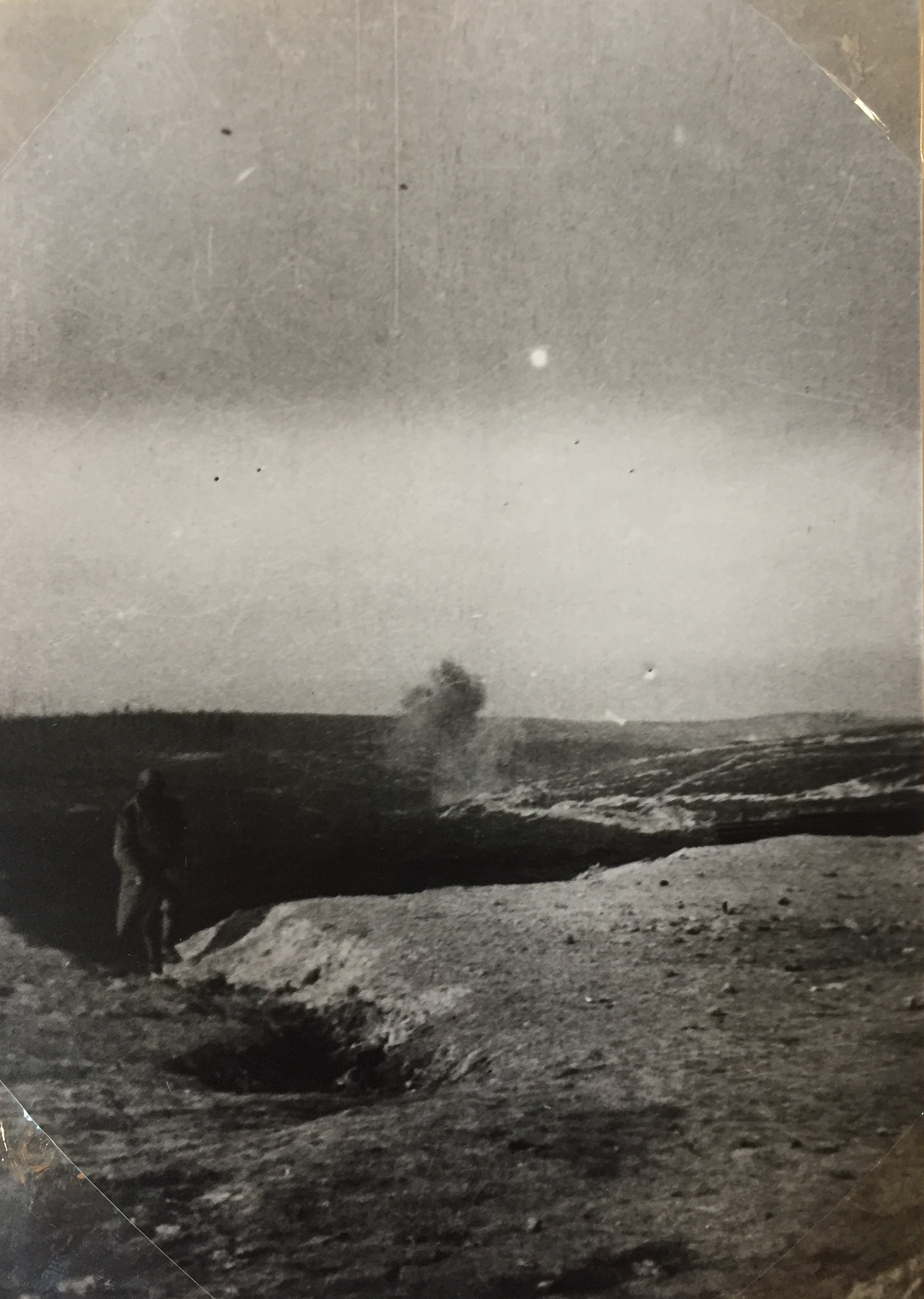

The Bois des Fosses and the Ravin du Helly in August 1917. Photos taken by Aspirant André L'Huillier.
18 August: In view of the regiment's participation in operations which must take place on both banks of the Meuse, the 151 was sent back up to the Ravin du Helly, where it would support an attack by its old division, the 42nd, on 20 August. The 1 and 2 Bats. leave their billets at nightfall and move up to occupy assigned emplacements. 1 Bat. shelters in the Ravin de la Caillette and 2 Bat. in the shelters MD of Fleury. The 3 Bat. remain at Camp de la Bouvoir (Belrupt) with Colonel Moisson and the general-staff, and the CHR at Haudainville. The relief up to the line was very hard, made so by the incessant fire from German artillery firing, HE, shrapnel, and copious mustard gas shells. The troops had no choice but to don their stifling gas masks and grope their way up the slopes in the darkness only punctuated by brief stabs of light from the explosions.
19 August: At night, the CHR and 3 Bat. move up to the front, sheltering in the Ravin du Helly-Est. Colonel Moisson sets up his PC at the Ravin du Helly. The territorial, Peirre Couraly, in the 309 RIT wrote a description of the sector when he was there in June and July 1917.
Never have my eyes seen such a spectacle of destruction and desolation. Everywhere there are only half buried bodies and laying all over, packs, rifles, grenades, shells, all mixed together among the dead. I don’t believe nature could ever produce something so horrific. Every inch of ground has been churned up by dozens of shells for hectares on end. Everything has been wiped away, even the largest of trees there remain barely a trunk which has not be splintered. The violence of the battle has been so strong that even the bodies of the dead are disinterred having only been buried a couple days earlier.The 151 is the head regiment of the 69 DI, which is in support behind the 42 DI. The next day, 42 DI must attack enemy positions along the front of Ouvrage des Fosses (north of the Ferme des Chambrettes) up to Saillant 2942 to the east. The division is in liaison to the west with the 125 DI, which must attack enemy positions in front of Beaumont.We go off to work every day at the Ravin de la Dame (i.e., Ravin de la Mort) 4 km from where were are stationed. Along the route we pass dead bodies, rifles, a whole mix of things. All in the middle of the night as well. With each blow from the pick, we uncover a head, an arm, a rifle, French and Boches alike. There are many Boches dead, I believe more than French. For as long as I live, I will never forget these frightening sights.
German POWs being escorted to the rear, 20 August 1917. Photos taken by Aspirant André L'Huillier.
20 August: The attack begins at 0440 hrs. The 151 remains in support. At 0600 hrs, 42 DI reaches all of its objectives but the Germans make great use of their new gas shells, which inflict deep burns on the flesh. The 332 RI suffer particularly badly from the gas. At 0600 hrs, General Delville, the 42 DI and the attack commander, alerts the 1 and 3 Bats. of the 151. The 1st Bat. is told that it will counter-attack in Hassoule quarter, hinging on the attack in case the enemy reacts and attempts from this side a right flank attack on the 42 DI. The 3rd Bat. will move in support of a battalion of the 332 RI which has suffered heavy losses. Ultimately though, Delville does not need to call on these two battalions, which are stood down at 0900 hrs. At nightfall, General Delville orders 3 Bat/151 RI to relieve the 6 Bat/332 RI in its emplacements. For another forty-eight hours, it was subjected to one the most powerful bombardments the men had ever experienced even by Verdun standards, with nothing but shell-craters in which to shelter.
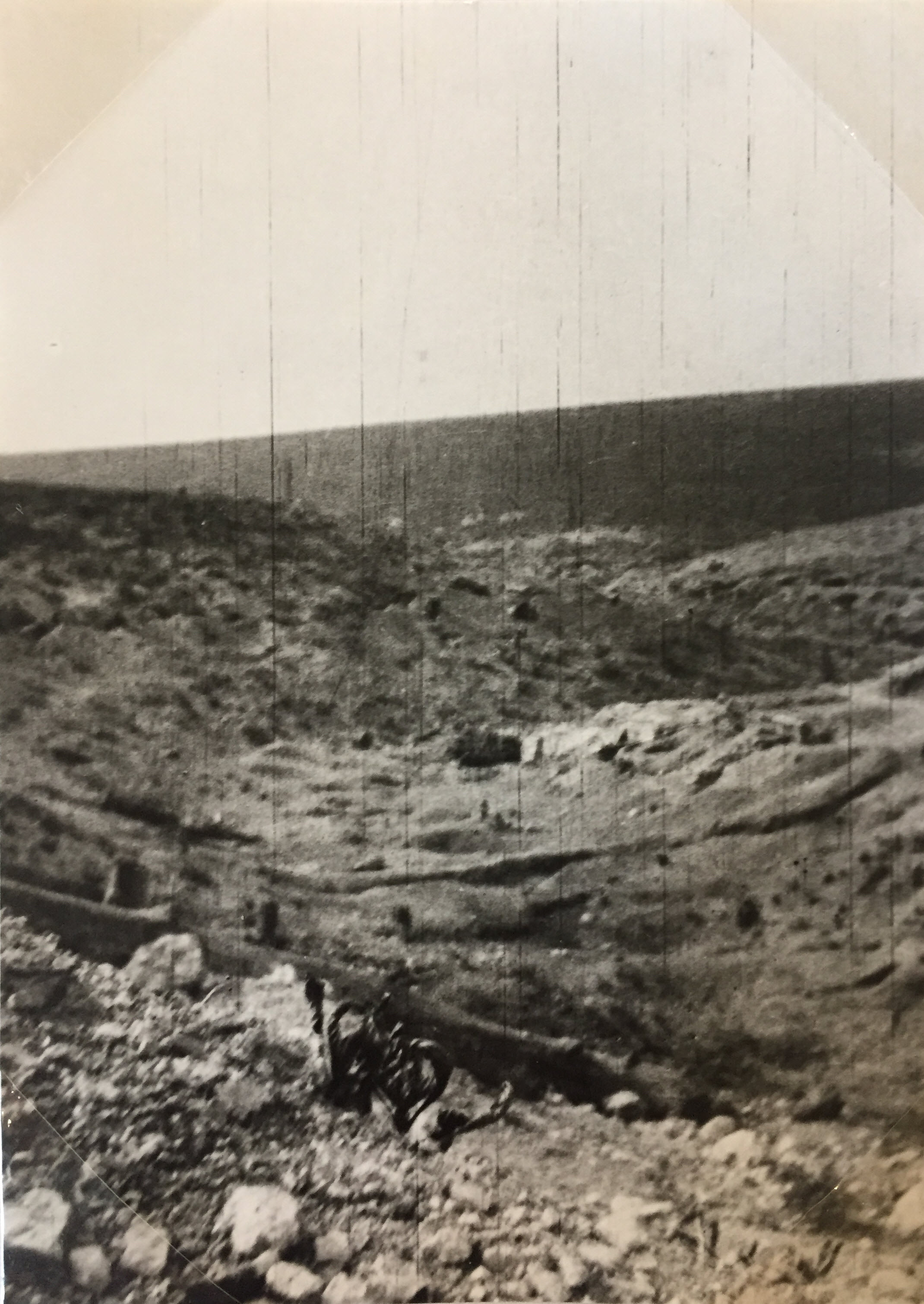
Ravin de la Caillette and Ravin du Helly, 20 August 1917. Photos taken by Aspirant André L'Huillier.
21 August: Despite a very heavy bombardment by shells of very large caliber and the barrages of gunfire, the relief is carried out successfully. The CM3 [3rd MG Co.] is not able to relieve the CM4/332 RI before daylight comes. After the relief is completed by 3 Bat/151 RI, the battalion is positioned as follows: 9 Co. to the left in liaison with 94 RI, 11 Co. to the right in liaison with 6 Bat/332 RI, 10 Co. in support in the Tranchée Ridolphi. The line occupied is a line of shell-holes, very heavily bombarded. The 2 Bat., which was at the shelters of MD Fleury, go to occupy the emplacements left open by 3 Bat/332 RI, knowing that 5 and 7 Cos. at Fort Douaumont, 6 Co. at the Ravin du Helly, the CM2 positioned north of Côte 347 and opening an indirect fire on the enemy's rear. No change for 1 Bat/151 RI. At 1945 hrs, the Germans launch a large counter-attack on the front of the 3 Bat. but does not reach the regiment's lines. After violent fighting, the integrity of the front lines is maintained.

Bois le Chaume in Sept. 1917. (source: Valois Collection)
22 August: During the day, enemy infantry and artillery is very active. The units of the 3 Bat. remains in position [in the Bois de Chaume], which work under fire to excavate a continuous trench line. At night, 1 Bat. in reserve at the Caillette shelters and the Ravin du Bazil, is ordered to move in support of the sub-sector of Bezonaux, Chamy quarter. The 1 Bat. is relieves the 1 Bat/7 RI, despite the very heavy poison gas shelling. Same situation for the 2 Bat.
23 August: Situation unchanged for 3 Bat, it's units working relentlessly to improve the organization of the first line and to dig a support line. The Germans heavily bombard all of the regiment's positions. At night the 1 Bat., which was in reserve, relieves in the first line the 2 Bat/129 RI in the Hassoule quarter. Situation unchanged for 2 Bat. except for CM2, which moves to the Tranchée Dalzan to open an indirect fire on the rear of the enemy.
24 August: The regiment continues to suffer under intense German bombardment. Bordinat recorded:
25 August: The German bombardment intensifies to an even more intense level and continues all day. At 1930 hrs, the Germans counter-attack along the front of the 3 Bat. and are able to penetrate into the first line. Yet a vigorous counter-attack by the battalion immediately throws the Germans back again. Along the front of the 1 Bat. in the Hassoule quarter, the Germans carry out a raid on the barricade but are repulsed with grenades without being able to reach the French lines.
Out of 450 we had [in 3 Battalion] on the 20th, there were barely 250 of us left by the 26th on the morning of the attack. Also, each man looks within himself and after this cruel, deadly period out in the open, the morale of the men and even the officers right now isn't too great either and no one has much confidence in success. Our goal is to take the Tranchée du Chaume and the Ouvrage de Lama, which was a den of machine-guns. Fortunately, provisions had arrived that night -- that is to say wine, water and a strong ration of booze -- which helped to raise morale of everyone that had only just been so low.
Sketch of 3 Bat/151 RI positions around 21 August 1917 (source: 151e RI regimental records).
26 August: At 0450 hrs, 42 DI launches an attack on the German positions with the assistance of 3 Bat/151 RI along its front (Tranchée du Chaume and Ouvrage du Lama). Though exhausted from the tremendous efforts already expended, the men throw themselves into the attack with great energy. 3 Bat. quickly takes all of its objectives and even surpasses some. In so doing, they take 66 prisoners, including an officer. The Germans counter-attack immediately, trying to retake the foot of the Ouvrage du Lama, launching several assaults to take back the lost positions, in particular Tranchée du Chaume. Each time, the Germans are beaten back and are unable to make any gains here. But 3 Bat. has suffered heavy losses during the course of the fighting.
On the front of the 1 Bat. in the Hassoule quarter, the enemy hammers the battalion's first line positions with heavy artillery. At 2345 hrs, the Germans launch a raid on the petit poste (advanced post) of the barricade but are repulsed, leaving many dead on the ground. At night, 2 Bat. is ordered to move to the Ravin de Neuville in support of the 8 BCP, 16 BCP, and 94 RI. Despite the curtain of artillery fire, which includes gas shells, the movement is carried out successfully. By the evening, as rain began to fall from the dark skies, 3 Battalion had been reduced to only 230 effectives (43 in 9 Co., 48 in 10 Co., 65 in 11 Co., and 74 in 3 MG Co.). Among the dead was Second Lieutenant Raymond Jubert. By then, Jubert was a Chevalier de la Légion d'Honneur and the recipient of the Croix de Guerre with two palms and stars of bronze, silver and gold for his multiple citations in the Orders of the Orders of the Army, Army Corps and Division.
27 August: 3 Bat. remains in place working actively to organize their conquered positions under continued heavy bombardment. 1st Bat. is also heavily shelled in the Hassoule quarter. At night, 2 Bat. leaves its supporting positions and goes to rest at the shelters of the Blancharderie firing range.
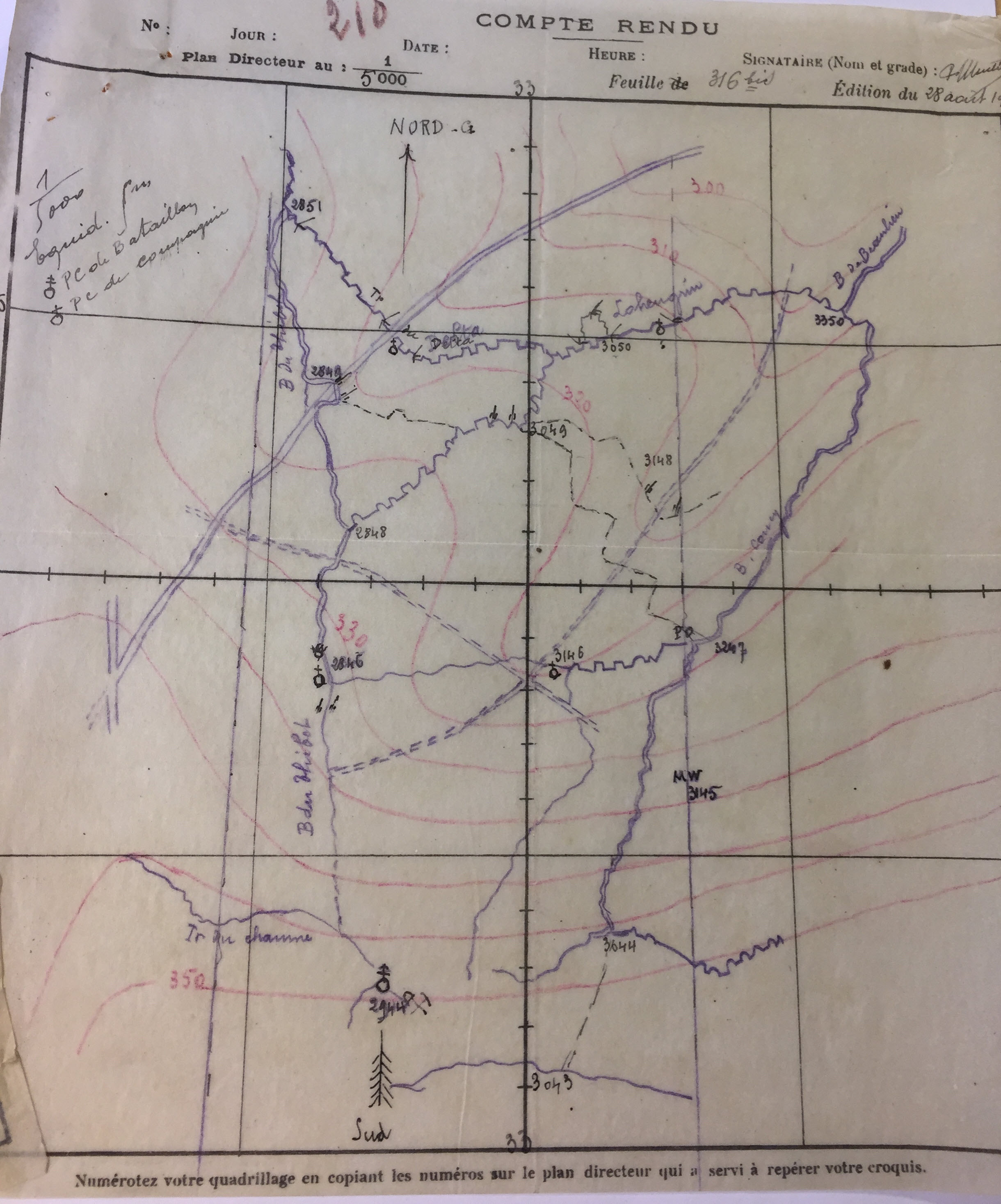
Sketch of the 151 positions on 28 August 1917. (source: 151e RI regimental records)
28 August: During the day there is no enemy infantry action but a heavy bombardment all along the line. At night, 3 Bat. is relieved by elements of the 162 RI with the battalion going back to the rest at the shelters of Caillette and Ravin du Bazil. To put 3 Bat.'s losses in greater perspective, on 28 August, regimental records reported the effective of 3 Bat. as follows: 9 Co. with 105, 10 Co. with 88, 11 Co. with 120, 3 MG Co. with 140 (453 total). By 29 August these numbers were: 9 Co. has 43, 10 Co. 48, 11 Co. 65, 3 MG Co. 74 (230 total).
The 2 Bat. moves up into the sector in support with 6 and 7 Cos. at Fort Douaumont and 5 Co. in the shelters close to PC Nice (south of Cote 347). The 2 MG Co., which was in position in the Tranchée Gabarre to carry out an indirect fire, went back in support in the shelters of Helly. No change for 1 Bat, in the Hassoule quarter. Losses for the regiment on 28 August include 3 killed and 17 wounded.
29-31 August: At night the Germans mount a strong raid on the front of 1 Bat. in the Hassoule quarter but in the face of a grenade barrage, are quickly forced to fall back to their lines. Losses for the regiment on 28 August include 2 killed and 15 wounded. On 30 August, the 3 Bat. goes back to rest at Faubourg Pavé. Losses for the regiment on this day include 4 killed and 4 wounded. The following day, the 3 Bat. marches to Senoncourt to be reconstituted. Losses for the regiment on 31 August include 1 killed and 9 wounded.
1-2 September: At night, 1 Bat. is relieved in the Hassoule quarter by a battalion of the 142 RI with the latter going to rest at Haudainville. The 2 Bat. goes back to join the 3 Bat. at Senoncourt to rest. Losses for the regiment on 1 September include 1 killed and 4 wounded. The next day there is no change but there was 1 killed and 2 missing.
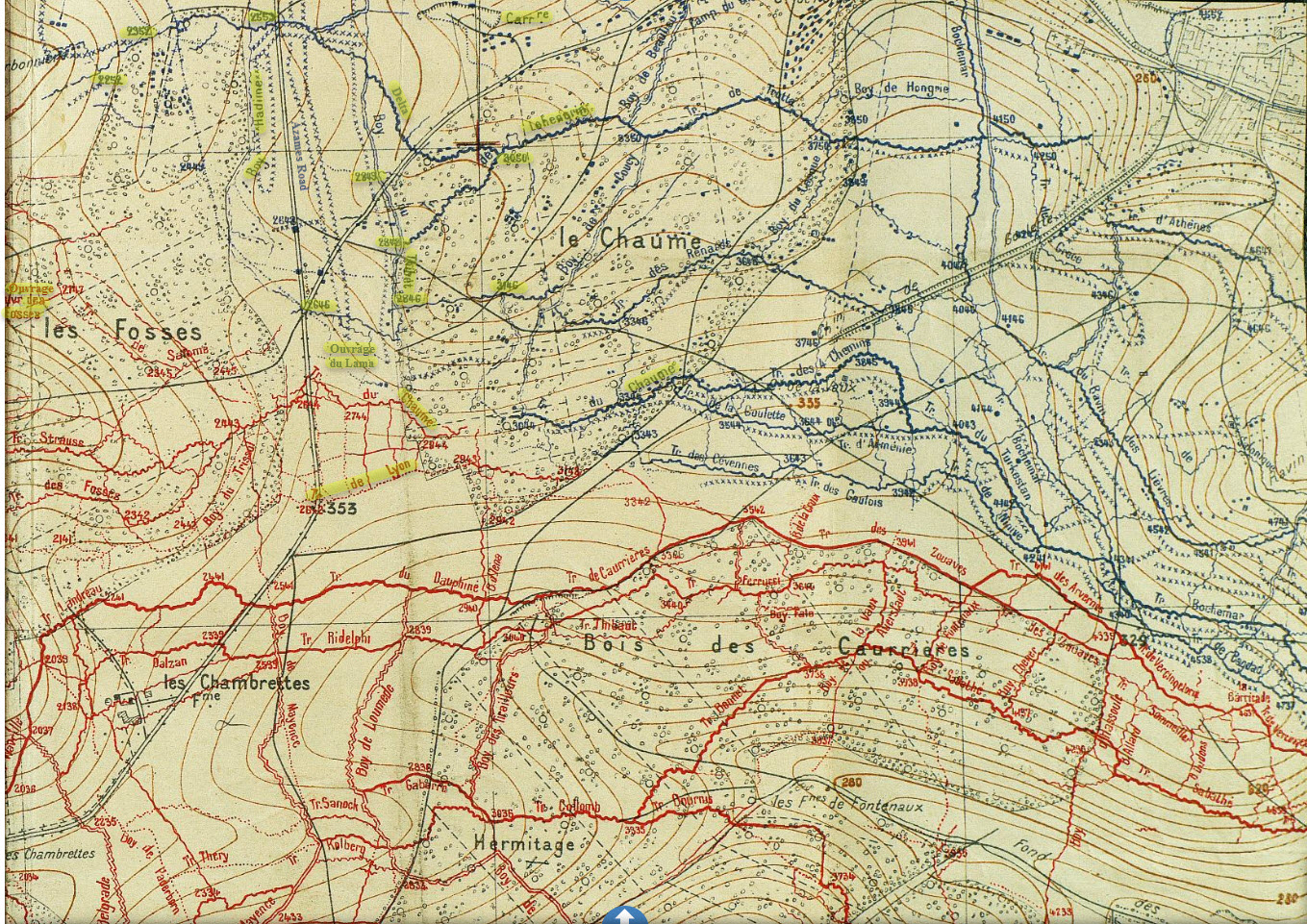
Map of the Bois des Caurières--Chambrettes sector September 1917. (sources: 162 RI JMO -- link to original here)
3-7 September: Transfers: Lieut. Ganot coming from the DD is assigned to 11 Co. and Sous-Lieut. Hergott coming from the DD is assigned to 10 Co. Losses for the regiment on 3 September include 1 killed and 2 missing. On 5 September the units are reorganized in view of an impending attack to be carried out by the regiment. Losses for the regiment include 2 wounded. The next day the regiment receives reinforcements. After these are incorporated, the 2 Bat. is transported back to Faubourg Pavé. The regiment receives orders on the night of 6 September that it would be going back up to the front -- its sixth and final rotation at Verdun. That night, the 2 Bat. marches up the attack zone assigned to it -- the trench south of Ouvrage du Lama -- where it relieves elements of the 267 RI. During the afternoon of 7 September, the 1 and 3 Bats. are transported to Faubourg Pavé and at night, make the same march up to their assigned sector. The 1 Bat. relieves elements of the 267 RI in the first-line to the west of and in liaison with 2 Bat/151. The 3 Bat. is in support in the Tranchées du Chaume, Salonée, du Dauphiné, and Ridolphi. Losses for the regiment on 7 September include 5 killed and 7 wounded.
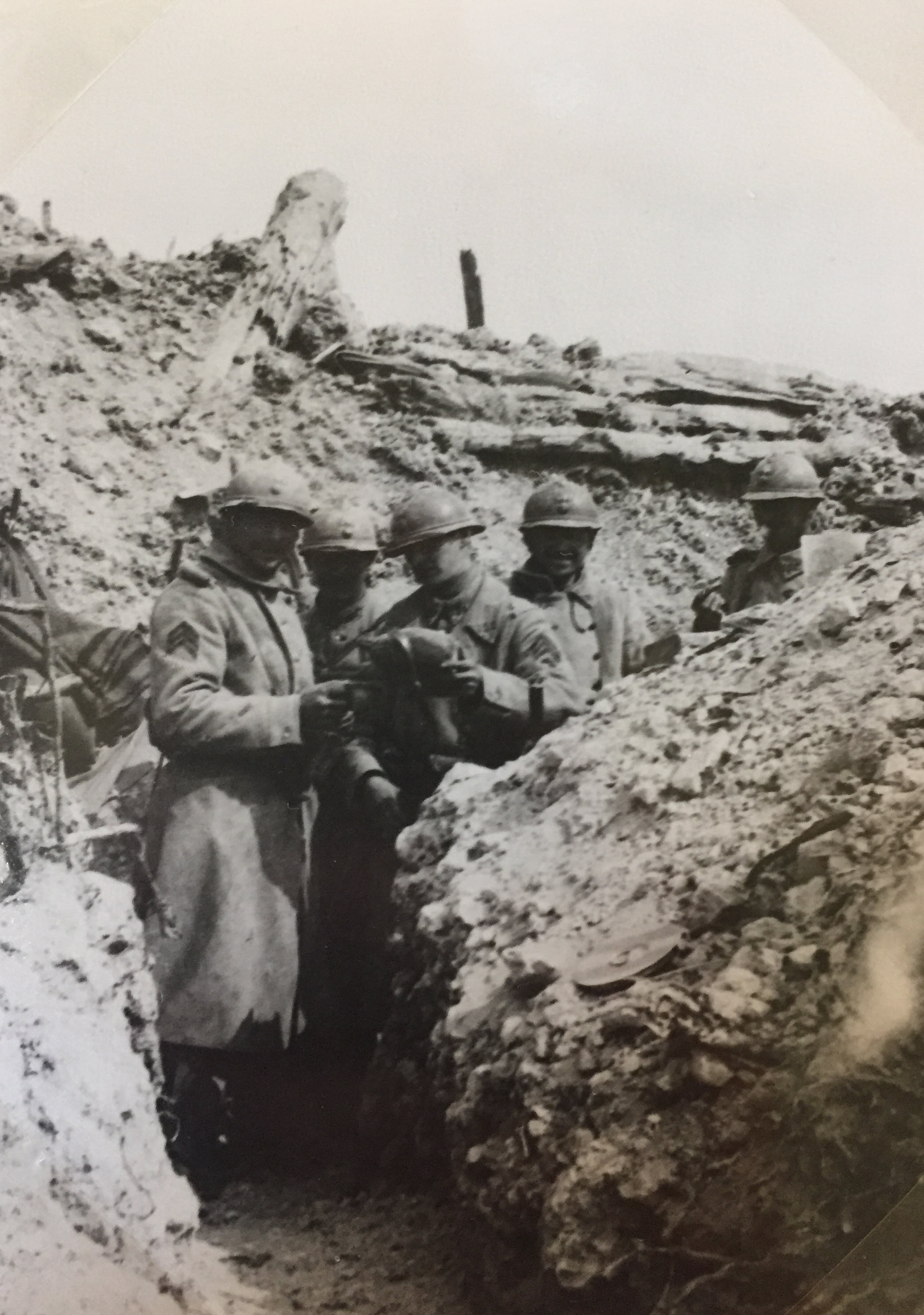
Lookouts from 11 Co. in Tranchée de Lyon before the attack, 8 September 1917. Gniôle (ration liquor) is distributed as shells burst in the background. Photos taken by Aspirant André L'Huillier.
8 September: L’Heure-H for the attack on the German trenches is set for 0510 hrs with the 2 Bat. in the first line on the right, the 1 Bat. on the left, the 3 Bat. in the second line. On the left of 1 Bat. is a battalion of 150 RI with a battalion of the 267 RI behind it. The disposition of the 1 Bat. is as follows: 1 Co. on the right in liaison with 7 Co., 2 Co. on the left in liaison with the 150 RI, 3 Co. behind 2 Co. in the second parallel and flanked by a platoon of 1 MG Co. The disposition of 2 Bat. is as follows: 7 Co. on the left in liaison with the 1 Co., 6 Co. on the right in liaison with a company of 169 RI, two platoons of 5 Co. in the second line and flanked by a platoon of 2 MG Co, the other two platoons of 5 Co. marching behind the right of 6 Co. along the limit of the zone between the 151 and 169 RIs. It will be in liaison with a platoon of the 169 RI. Lieut. Pégon (5 Co.) commands this detachment. The 3 Bat. occupies third parallel called Tranchée Bordeaux in the order (from left to right) of 10, 9, 11 Cos., with an element of this last company also occupying Ouvrage Strauss, along with 3 MG Co.
Objective: The objective of the operation is to seize Tranchée de Mésopotamie and Tranchée Lohengrin from point 2252 up to point 3050, together with the 169 and 267 RIs in liaison to the right and left, respectively (whose mission was to firmly hold point 2252).
Execution of the Attack: At 0510 hrs, the 1 and 2 Bats. depart the first line. At this time, it was still not light out. Added to this was a heavy fog and thick smoke produced by the bombardment by both French and German artillery, which only made things more obscured. Units had to navigate by compass (angle of march 16 degrees). The 1 and 2 Cos. of 1 Bat. were charged with taking Tranchée de Mésopotamie between the Boyau du Thibet, point 2851, and 2552. The 1 Co. was also responsible for mopping of the shelters west of point 2849 and the 2 Co. the Boyau Hadimé from 2549 up to 2552 (included).
The 1 Co. is met with a volley of grenades 100 meters northwest of 2646 in Boyau Hadimé. It skirted around this grenadiers post and continues its progression but this is made extremely difficult by the ground churned up badly by the bombardment. Many men lose their direction and get separated from their commanders in the darkness, fog and smoke. Some platoons went off course or got entirely turned around in the fog. At one point, Captain Bourgoin’s came under grenade attack at his command post by an aspirant from 3 Company. Fortunately, the misguided officer was less powerful offensive grenades and no one was injured. Already down on his luck after losing one of his boots to the mud at the start of the attack (he would improvise one out of a piece of canvas), Sous-Lieut. Basteau had his helmet is knocked off after being struck by grenade thrown by a sergeant who was targeting a group of Germans. Basteau continued the rest of the attack helmetless with only one shoe.
The 2 Co. is stopped in the Boyau Hadimé 80 about meters south of 2552 by a strong center of resistance established at this point. Lieut. Lecointe is wounded and passes command to Sous-Lieut. Lecerf, who then rallies the 2 Co. and deploys it along Boyau Hadimé facing 2552. A part of the 1 Co. lost in the fog obliques too far to the west brings it to west of Boyau Hadimé towards 2549. The difficulties of the advance and the heavy fog leaves the 1 and 2 Co. unable to keep up with the rolling barrage.
The 3 Co. alone manages to maintain its trajectory. Capitaine Cormier rallies lost elements of the 2 Bat. and those of the 150 RI, directs them to Tranchée de Mésopotamie. At H 30’, a platoon of 1 Co. under Adjudant Letellier reports he is in Tranchée de Mésopotamie. The 2 Co. is stopped and the rest of 1 Co. is in the 150 RI’s zone of action. At H 1 hrs 30’ the situation of the battalion is as follows: to the east and west of 2851, a platoon of 1 Co. with a platoon of 1 MG Co. and some men of 2 Co. have erected a barricade 100 meters east of 2853. Along the Boyau Hadimé about 80 meters south of Tranchée de Mésopotamie, two platoons of 2 Co. are at 2549, while two platoons of 1 Co. have rallied and are in support of 2 Co. Along the Azames road between 2549 and 2849 is 3 Co.
Meanwhile, from the moment it had departed its parallels, 2 Bat. came under the fire of German artillery. Sous-Lieut. Nuttens (2 MG Co.) is wounded, as is Lieut. Le Tollec (37mm canon) who had been order to deploy to guns in order to take the Azames road and Boyau Thibet by enfilade. Adjudant Leoy of 6 Co. is killed. The companies in the first line skirt around and outflank Ouvrage de Lama, taking the German defenders entirely by surprise. The enemy nonetheless puts up a fight and opens fire in the back of the advancing waves. Trench cleaning platoons from 5 Co., assisted by a platoon of the 3 Bat. (under Aspirant Pochon of 11 Co.) burn the enemy shelters and take the first prisoners. Capt.-Adj.-Major Bazaille seizes a German officer and a NCO an orders them to have their men immediately cease fire. Cmdt. Martin then interrogates this officer and learns that there are three companies of the 1 Bat/130 Regiment occupying Ouvrage de Lama. He then has the German officer lead him to the entrances of the saps and has the man order all the occupants out to surrender and line up behind him, this being carried out immediately. The 6 Co. progressing in its zone of action and assisted by a platoon of trench cleaners under Sergent Gudin (5 Co.) mopped up the shelters at 3148 and taken numerous prisoners as well (belonging to 2 Bat/130 Regiment).
At H 30’, Tranchée Lohengrin is taken by 6 Co., which places its right on the point fixed to be in liaison with the 169 RI. The 7 Co. being a little off its direction has drifted to the west. Tranchée du Delta being so completely obliterated by the French bombardment is no longer discernible. Lead by the energy of its commander, Sous-Lieut. Delot, a platoon of 7 Co. follows a portion of Mollet’s trench cleaners platoon (5 Co.) beyond its objective and disappears in the fog and smoke in the direction of Carrière 2952. Cmdt. Martin alerted by Capt. Bazaille That a gap exists between the 6 Co. and the 1 Bat., and that elements of 5 Co. needed to immediately advance to plug it. This unit must immediately establish the liaison in the Tranchée de Mésopotamie with Le Tellier’s section and a section of the 1 MG Co. positioned there.
The mission of 3 Bat. was to reinforce the battalions of the first-line with the 11 Co. and 3 MG Co., the other companies receiving special missions. The special mission of 9 Co. was to advance at
The special mission of 10 Co., being placed behind the assault waves of 2 Bat., were to proceed to mop up the shelters of the Ouvrage du Lama, the area around Ouvrage du Thibet, zone 2846 and shelters further north of the zone 2945, and the minenwerfer emplacement.* The company would next occupy Ouvrage du Lama, the zone of 2846, making itself ready to advance via Boyau Hadimé or, if necessary, Boyau de Thibet. At 0600 hrs, the detachment of trench cleaners had already taken numbers prisoners. At 0900 hrs, the situation of 3 Bat. is as follows. The 9 Co. has two sections in Boyau Hadimé between 2547 and 2644 and two sections in Tranchée du Chaume in zone 2644. The 10 Co. has two sections in the Ouvrage du Lama and in Ouvrage de Thibet in zone 2744 and two sections in Tranchée du Chaume in zone 2744 and Boyau de Thibet. The 11 Co. in Tranchée du Chaume and either side of 2744.
Regimental records notes this trench cleaning element was comprised of one section under the orders of Aspirant Pochon, which is supplemented by a squad of grenadiers from another section. This element was split into three groups, each with its own special mission. The first group (under Sgt. Nys) with one caporal and four grenadiers from 3e Section and four from 2e Section was tasked with mopping up the shelters of Ouvrage du Lama. The second group (under Aspirant Pochon), Sgt. Delacour, one squad of grenadiers, two FM gun teams and two marksmen was tasked with mopping up Boyau du Thibet. The third group (under Sgt. Clouer), four voltigeurs, one FM gun crew was tasked with occupying the minenwerfer at 2945.
Sous-Lieut. Lecerf (2 Co.) reports that he is unable to establish a liaison to the left with the 150 RI and that he is in danger of having his left turned back. The 1 Bat/150 RI, after arriving at 2552 having taken Tranchée de Mésopatamie, was violently counter-attacked and forced to retreat to its departure trenches. Capt. Bourgoin (commanding 1 Bat.) immediately dispatches a section of 1 MG Co. and half of 3 Co. (Dufresne's "platoon") to maneuver by the west to 2552 to help 2 Co. reduce this center of resistance and reestablish the liaison with the 150 RI. Despite all his efforts, Sous-Lieut. Dufresne is unable to accomplish his mission and is unable to establish a liaison with the 150 RI (back in its departure trench).
As for 2 Bat., Delannay’s “platoon” (7 Co.) is positioned to the left of 6 Co. in Tranchée du Delta. A gap exists between it and 6 Co., the gap being filled in by two sections of 5 Co. However, these sections are greatly reduced having suffered numerous casualties and consist of no more than 20 rifles in total. Colonel Moisson, having learned of the difficulties encountered by his 1 Bat. and the 1 Bat/150 RI in taking point 2552, puts the 9 Co. at the disposition 1 Bat. commander in order to resume the attack. This attack goes off at 1640 hrs under the command of Capt. Gautret (1 Co.) but is completely checked by intense machine-gun fire coming from 2552, 2553, and the shelters south of 2452. The 150 RI, which was to participate in this attack, is unable to even step off. At 1600 hrs it is reported that the 169 RI had encountered a delay in its advance owing to an enemy counter-attack through Boyau de Coucy. Colonel Moisson orders 11 Co. to this point, in liaison with 7 Co. In the event, the attack makes no headway.
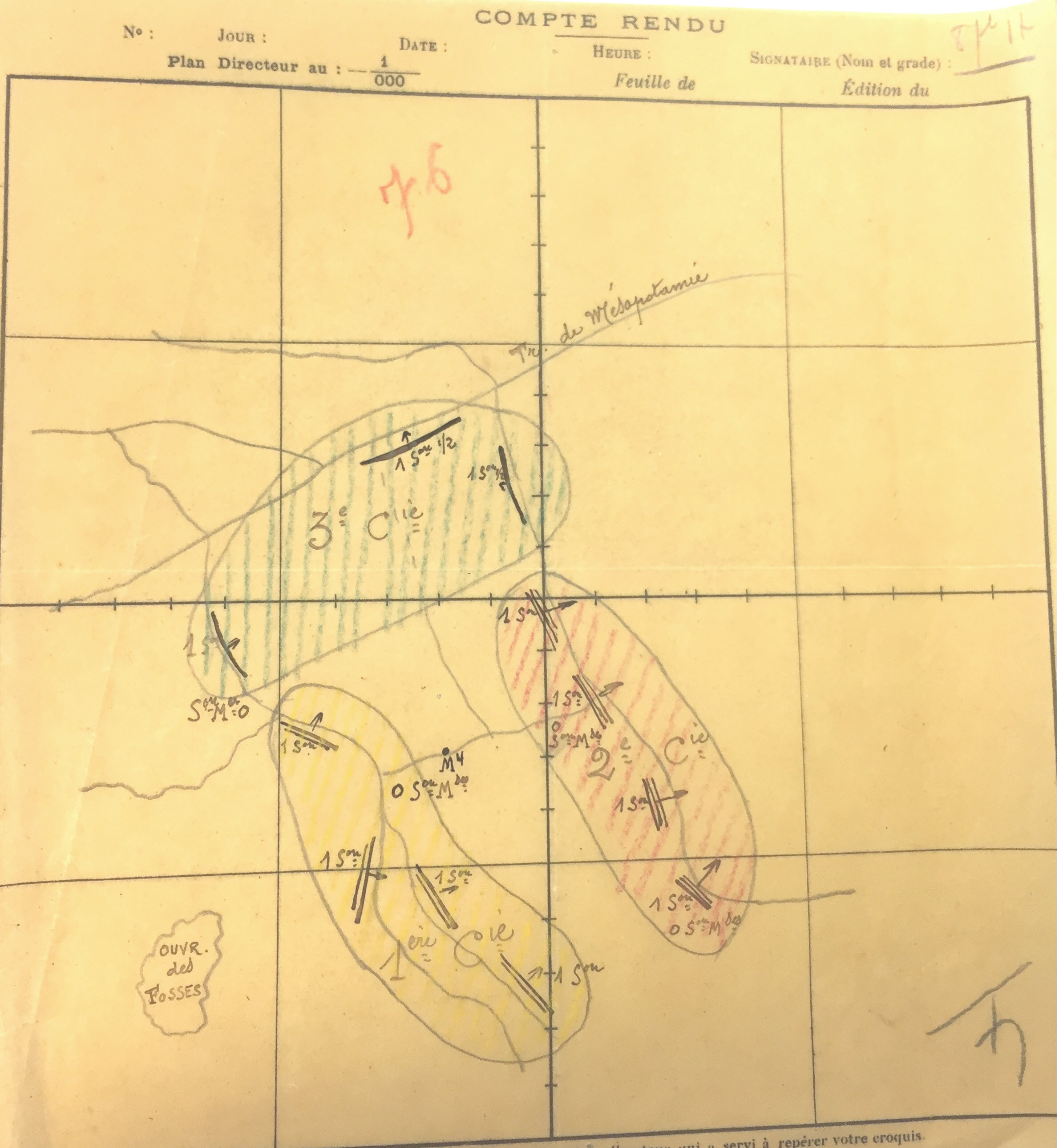
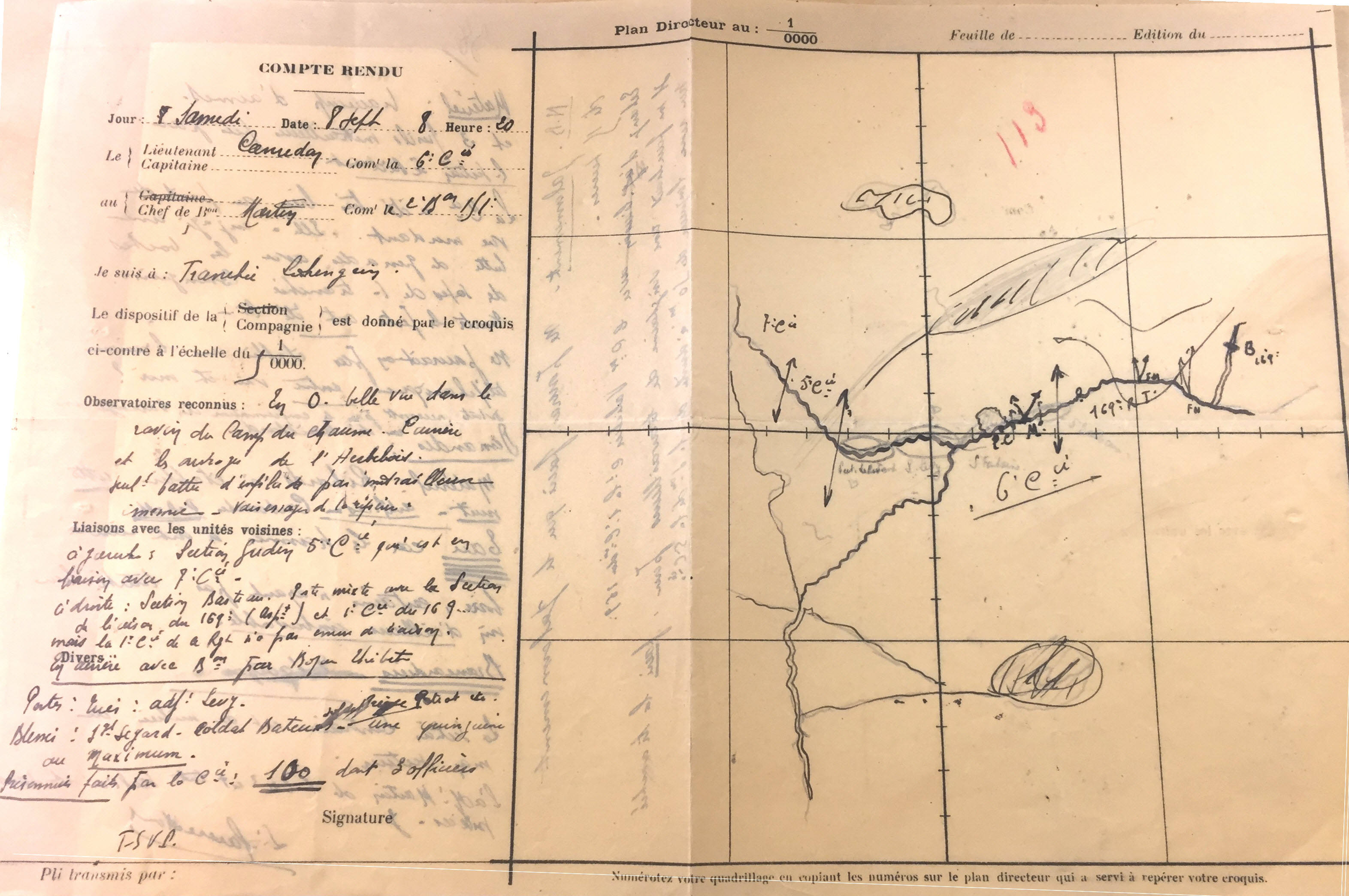
Left: sketch of the positions of 1 Bat/151 RI on 8 September 1917. Center and Right: sketches of the positions of 2 Bat/151 RI on 8 September 1917. The accompanying situational report completed by Lieut. Cauredon (commanding 6 Co.) pleads for water to be sent up as his men had nothing to drink. (source: 151e RI regimental records)
The situation at 2000 hrs is as follows. The 1 Bat. is in Tranchée du Delta with a section of 1 Co. along with elements of 2 Co. and a section of 1 MG Co. is in Boyau Hadimé. The 2 Co. holds the barricade and is echeloned in the boyau. To the west of 2 Co. Dufresne’s “platoon” (3 Co.) is in liaison between 2 Co. and 5 Bat/267 RI in the departure trench near 2448; to the east of 2 Co. is a “platoon” of 1 Co. which is unable to establish liaison with the rest of the company in Tranchée de Mésopatamie. To the west of 2849, is the other “platoon” of 3 Co. At 2130 hrs, Colonel Moisson orders 9 Co to pass up to the first-line in Tranchée du Delta to replace the weary elements of 1 Bat. The 11 Co., which is in support of 1 Bat., is in Boyau Hadimé at the disposition of 1 Bat. commander. A relief is carried out around midnight with a section of 1 Co. left at the disposition of 9 Co. in Tranchée du Delta. The 2 Bat. is positioned between 2851 and 3350 in the following manner: from left to right, 1 Co., half of 5 Co., 6 Co., half of 5 Co. around 3146 and in liaison to the right with 7 Co/169 RI and to the left with three sections of 10 Co. The fourth section of 10 Co. has been pushed up in close support of 7 Co. at 2848.
In summary, despite great challenges owing to the heavy fog and difficult terrain, the 151’s attack was a success, with the exception of the zone around 2552. The important Ouvrage du Lama was taken and at least 350 prisoners (including 7 officers) were captured, together with considerable material, a dozen machine-guns, automatic-rifles, munitions, equipment, rations and all manner of objects. If the attack on 2552 had not been entirely successful, it is owed to the units of 1 Bat. being unable to keep up with rolling barrage and getting dispersed in the heavy fog. The Germans had enough time to recover and when small elements of 1 Bat. arrived near 2552 and 2553, they encountered the enemy exiting his shelters, with machine-guns set up and grenadiers at their posts. Surprise was not attained. Moreover, the artillery preparation on these points had not been effective because of the terrain being a counter-slope and aerial observation was not possible. Along with the 1 Bat/150 RI, the 151 captured a total of 462 enemy soldiers and 16 enemy officers. The regiment would once again be cited in the Orders of the Army for its actions:
"[The 151] Regiment composed itself very well under fire. Under the command of Colonel Perchenet has checked the enemy advance and has contributed through its obstinate resistance broken the Germans' efforts."Yet despite the official unit citation, for those going through these nightmarish days, it must have all been so horrifyingly similar to every other attack. Moving up into the Ravin d’Hassoule with 1 Battalion the week before Captain-Adjudant-Major Bourgoin experienced scenes that was depressingly familiar to those who’d been at Mort homme the year before.
Approached the north slope of [Fond] des Rousses, encountered a bombardment of an inconceivable intensity. My battalion felt like it was cut off from the other defense sectors. The telephone line was constantly being cut, the TPS [ground telegraphy] unusable, only one liaison agent with the artillery limited to signalling with flares and with the commander using light optics to Fort Douaumont. But smoke and fog often made these two means of communication insufficient. There were some voyager pigeons as well, but these were reserved for emergencies.Losses for the regiment on 8 September include 32 killed (incl. Lieut. Pautet), 206 wounded (incl. Capt. Bazaille, Soust-Lieuts. Nutteus, Giroux, Dufresne, Lecerf, Lemote, Cartier), and 116 missing (incl. Sous-Lieuts. Delot, Mollet, Boyer).The bottom of the ravine was being ceaselessly churned up by shells. The bodies of French and German dead which had been buried were constantly disinterred. Our stretcher-bearers faced great risks to rebury them each night and with evacuations made so difficult, our wounded were also left. We'd been sent up into line for four days but were left for ten. And we had no trenches. The units occupy lines of shell-holes, all mixed all together. The central boyau in which we arrived is dug out each night, as every day it was leveled by the minenwerfer opposite us which sent over bombs weighing 200 kilograms [440 lbs]. Despite our strength in artillery (six groups of 75mm comprising seventy-two cannons and two groups of 155mm, 1 battery of 220mm mortars, and one battery of 58mm mortars) the battalion still felt like it was insufficiently supported.
French artillery shelling first-line German trenches in the Bois des Fosses (left) and the Ouvrage du Lama (right). Photos taken by Aspirant André L'Huillier.
9 September: At 0500 hrs, 1 Bat. launches an attack to take 2552. A platoon of 9 Co. attempts to advance on the object by proceeding through Tranchée de Mésopatamie, while a section of 11 Co. looks to do the same by advancing through Boyau Hadimé. The 1 Bat/150 RI is also ordered to attack again. In all cases, the attacks are checked by the enemy, especially by German grenadiers, which alert the machine-guns at 2552. The 1 Bat/150 RI manages to reach the railway line in at 2352 but can go no further. The situation remains unchanged until around 1900 hrs. At this time, the Germans unleash an intense bombardment and the counter-attack from 2552, progressing through Boyau Hadimé and advance 100 meters using grenades. The French units, having no grenades, is forced to fall back but puts up a tough fight using their rifles. The situation is quickly rectified an hour later as soon as grenades are brought up and distributed. In the night of 9-10 Sept., the 3 Bat. relieves the exhausted 1 Bat., with the former going back to Tranchée du Chaume.

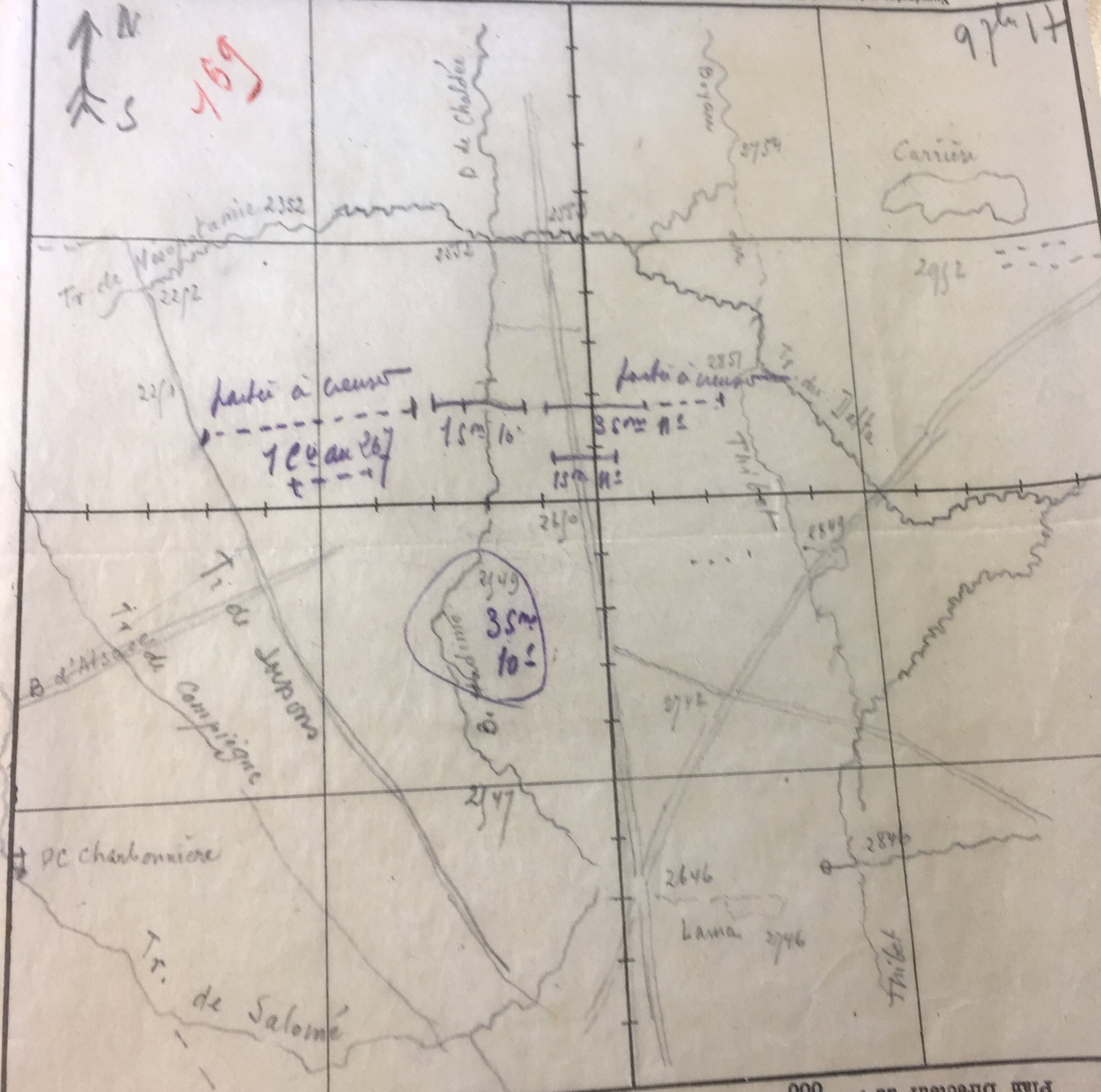
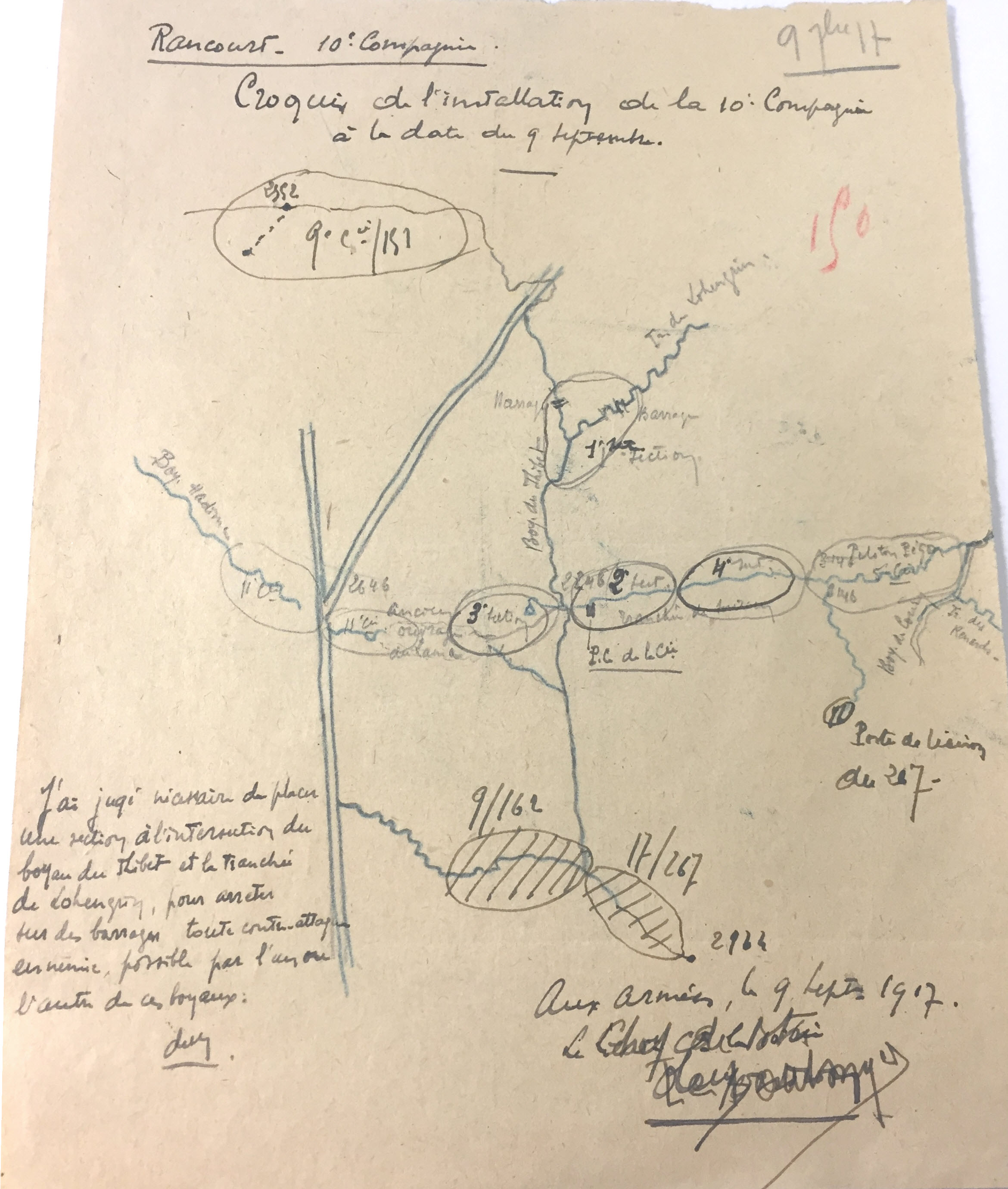
Sketches of 151 RI's (and 150 and 267 RIs) shifting positions from 9 September 1917. From left to right: positions of 3 Bat/151 RI; positions of 10 Co., positions 9 and 10 Cos. (source: 151e RI regimental records)

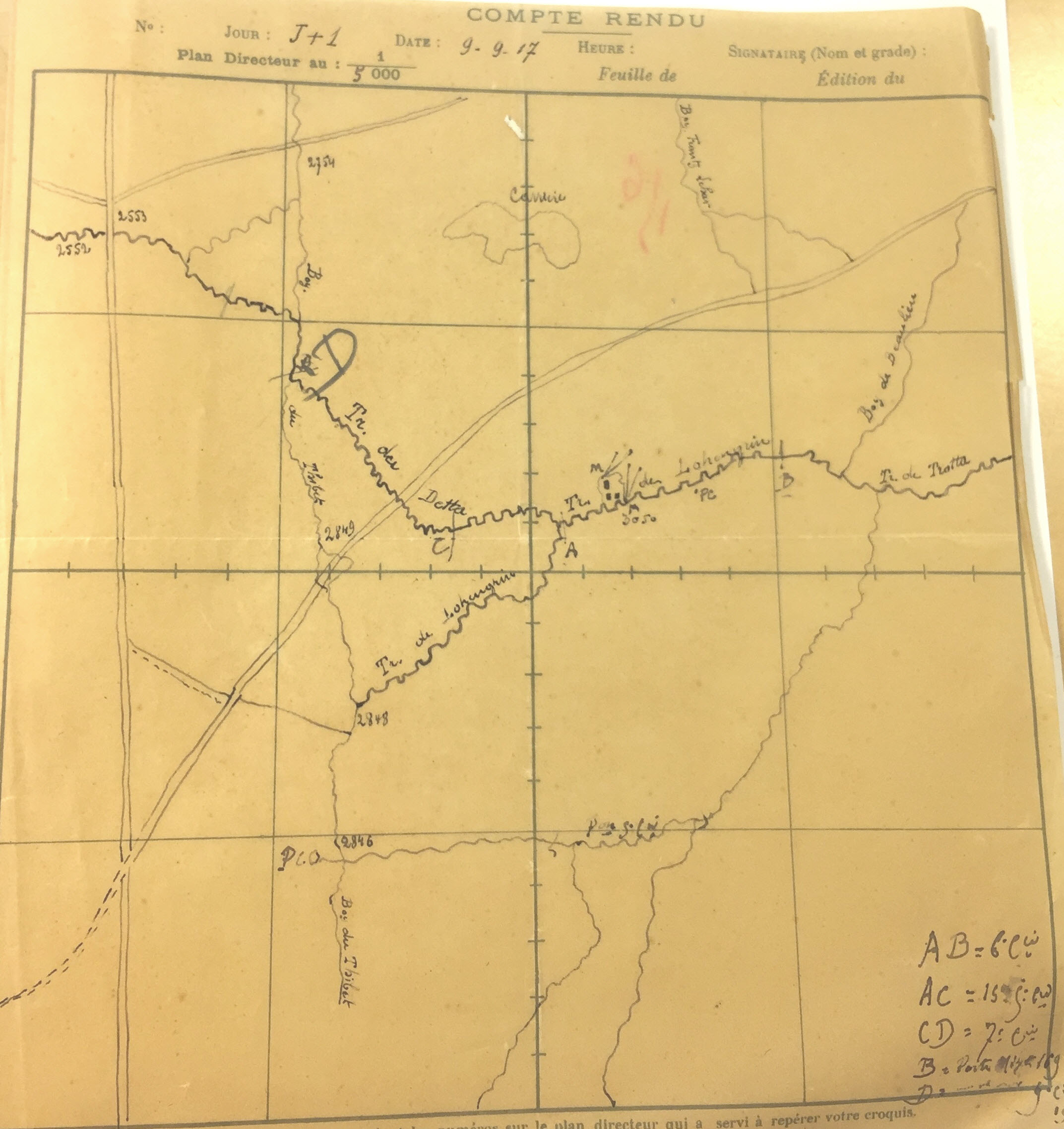
Sketches of 151 RI (and 150 and 267 RIs) shifting positions on 9 September 1917. Left: positions of 1 Bat/151 RI. Right: positions of 2 Bat/151 RI (source: 151e RI regimental records)
The situation at the end of the day is as follows: 9 Co. is extended into Tranchée du Delta and relieves the remaining elements of 1 Bat. The 10 Co. is placed alongside Boyau Hadimé, with two sections in line and two in support. The 11 Co. is to the east of the Azannes road, with three sections in line and one in support. Liaison is reestablished with the 150 RI on the left but there is no liaison on 9 Co.’s right. Contact is only made by patrols sent out during the night. A FM (Chauchat) post is set up in a shell-hole before dawn in order to flank interval between 9 and 11 Cos. Losses for the regiment on 9 September include 22 killed, 98 wounded (incl. Lieut. Tollec), and 28 missing.
Left: Map of the Bois des Caurières sector 10 September 1917. (sources: 169 RI and 150 RI JMOs)
10 September: A new attack is ordered by Colonel Moisson to take the important communications hub of 2552. The attack will take the form of a raid and the artillery barrage must box in the ground desired for a period of an hour. The barrage will open five minutes before the attack and advance in a rolling fashion to the north of Tranchée de Mésopatamie where it will then remain fixed. The 11 Co. will be covered on its left by two sections of 10 Co., which will bound forward in a single rush upon the enemy trench. This movement will be strengthened by a section of machine-guns along with special groups of the 1 Bat/150 RI, departing from 2352 and operating through Tranchée de Mésopatamie.
The attack group is in place at 0320 hrs. While the units get into position, an short but intense enemy barrage by heavy caliber shells is unleashed, inflicting significant losses in the attack units. At L’Heure-H (0530 hrs), despite the enemy fire, challenging terrain and difficulties in maintaining liaisons, the units attack with vigor and makes it a short distance from the fixed objective. The enemy barrage opens exactly at the moment the attack goes off and numerous enemy machine-guns enter into action, primarily around point 2554 (Boyau Chaladée) and a little to the north. Other machine-guns set up out in the open around 2554 and on the top of Boyau Chaladée (the continuation of Boyau Hadimé after interesecting Tranchée de Mésopatamie). All of these guns open fire on the attack units in a deadly cross-fire and force a halt to the attack. The units regroup around 0600 hrs at the departure point.

Sketches of 151 RI's positions on 10 September 1917. (source: 151e RI regimental records)
Having once again run out of water and with no provisions making it up their positions, the men tried to collect rainwater using their tent-canvases but the taste of it was awful. For another five days, the depleted battalions of the 151 grudgingly fought on, trying unsuccessfully to take more ground while fighting off multiple enemy raids and counter-attacks. Unfortunately, 1 Battalion had forgotten to search all the shelters, our enemies being masters in this art. These were usually dug down deep and were well-equipped, sometimes sheltering whole companies.
Believing that the enemy was completely driven out, they began to dig and to organize the trench, leaving their weapons and picking up shovels and pickaxes instead. Suddenly they came under attack by the enemy from behind and elsewhere, who were armed revolvers and grenades. Within the great struggle, there were innumerable acts of bravery displayed. There was Corporal Caillet (1 MG Company) who was encircled with a handful of his men by a dozen Germans who’d taken his machine-gun. Caillet put up a fierce fight to get it back using grenades and his revolver, and then the legs of the gun's tripod after disengaged the gun barrel. He succeeded in getting the gun back, along with taking several enemy officers and men prisoner. For his actions he would be promoted sergeant and to the Légion d’Honneur, his medal being pinned by General Pétain personally. Aspirant Pochon (10 Company) didn’t realize he had advanced beyond the flattened German first-line and pushed on ahead. Isolated from the rest of his unit, he was forced to shelter in a shell-hole for the entire day under a terrific fire of enemy shells before eventually navigating back to friendly lines by compass. Later, when his unit’s advance was checked by the fire of an enemy machine-gun, he set off on his own and circled around the gun before closing in on it from the flank and capturing the captain commanding the unit and the gun crew.
It was while leading his platoon through a boyau that L’Huillier was wounded yet again; his fourth time and on this occasion, seriously. L'Huillier was fighting with his platoon, using grenades to wipe out enemy defenders, when he spotted a very young German in the boyau. At the same moment as L'Huillier pulled the pulled in the pin on his grenade, the German boy threw his own. Thinking it would fall to the left of the boyau, L'Huillier committed to throwing his own grenade. Just as he released it, the German grenade exploded on the edge of the trench close to beside him. L'Huillier's entire left side was riddled with fragments and his left arm broken. He’d received multiple wounded to the face, including a deep cut above his left eyebrow penetrating the sinus. His arm and leg was badly lacerated and his knee fractured.
Bleeding profusely from his face and arm, he told his orderly to cut the leather lace from one of his leggings to use as a tourniquet for his left arm. The man then used L'Huillier's handkerchief as a band to tie around his left eye, which he could no longer see from. It was impossible at that moment to be evacuated with the enemy all around. L'Huillier began issuing instructions to his men, telling them to block the boyau with anything they could find, and when Aspirant Ponchon arrived to take over command of the platoon, he provided him with counsel too. When several men try to get L'Huillier out, one is struck in the shoulder and he orders them to leave him where he was. His wounds continued to hemorrhage profusely as he bled through his three dressings. But as night fell and he was still alive, L'Huillier was at last taken back on a stretcher to the regimental first-aid post.
From there, L’Huillier was taken on a long and painful journey back to the divisional first-aid post at the Carrières d’Haudraumont, where the 151 had sheltered during its first tour the previous March. After his wounds were dressed (his eyesight returning to his left eye after the blood had been washed out), he was loaded into an American Red Cross truck and driven to a hospital in Verdun before being sent on to Château du Petit-Montheron. L’Huillier would finish up the rest of the war in convalescence, gradually recovering from his wounds, which left him permanently scarred. For his actions, he would receive a Croix de Guerre with palm and a promotion to the Chevalier de la Légion d’Honneur with the a citation that read:
"Young officer of courage, ardor and temerity. On 9 September 1917 at the Bois des Fosses, energetically maintained his platoon at its post by his good example despite a heavy artillery fire. Then, led his platoon into the attack against a strongly held German trench, where he was seriously wounded. Has made a superb example of coolness, decisiveness, and bravery to all. Four times wounded and three times previously cited." --Signed: DEBENEY
Aspirant André L'Huillier recovering from his wounds at Chateau du Petit-Montheron (near Bar-le-Duc), 19 September 1917. His cousin, Médecin-Major Gentil, sits beside him.
Meanwhile, losses for the regiment on 10 September include 17 killed (incl. Lieut. de Mondion and Sous-Lieut. Walime), 64 wounded (incl. Lieut. Ganot, Sous-Lieuts. L’Huillier, Gund), and 15 missing (incl. Sous-Lieut. Hergott).
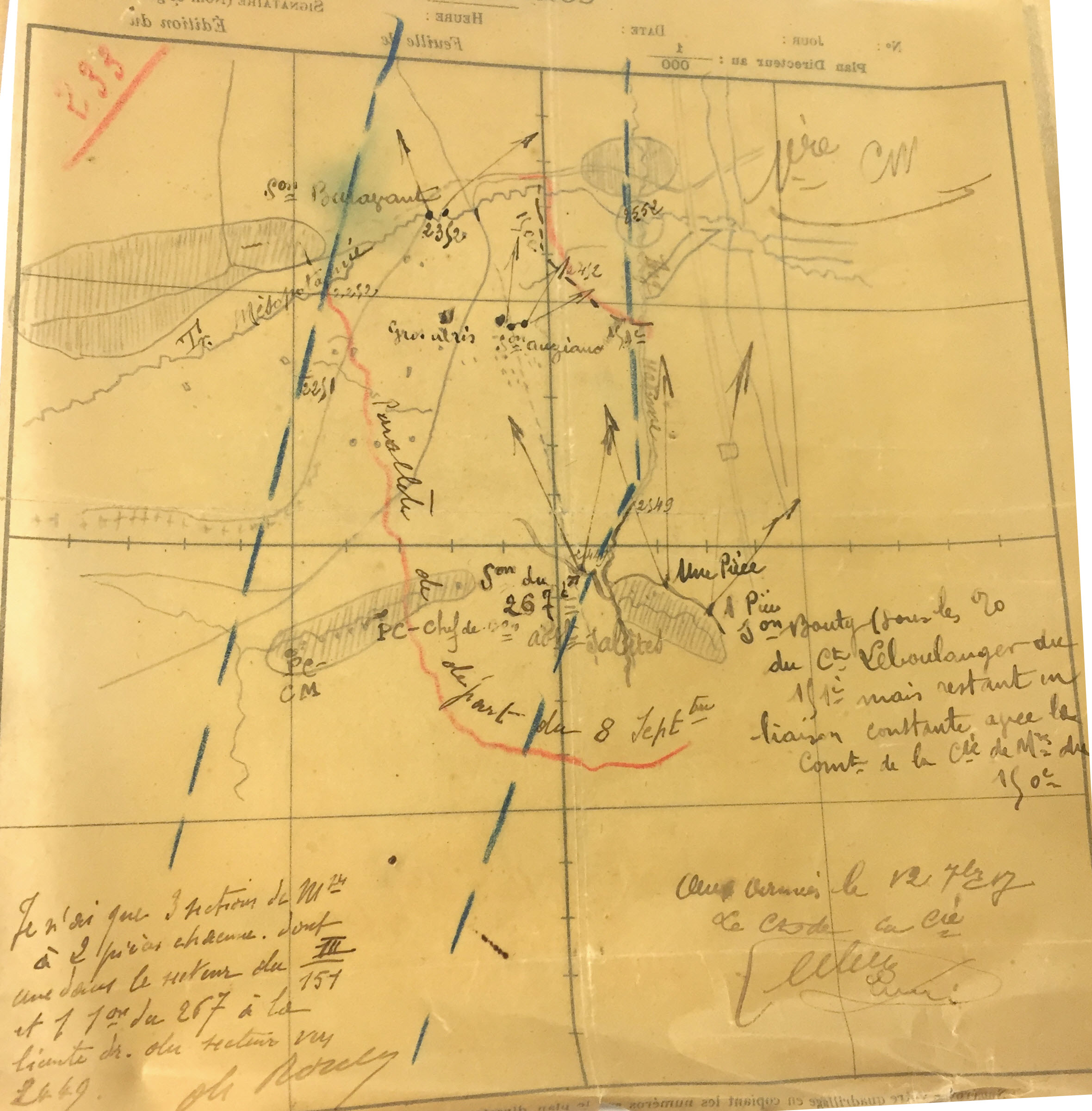
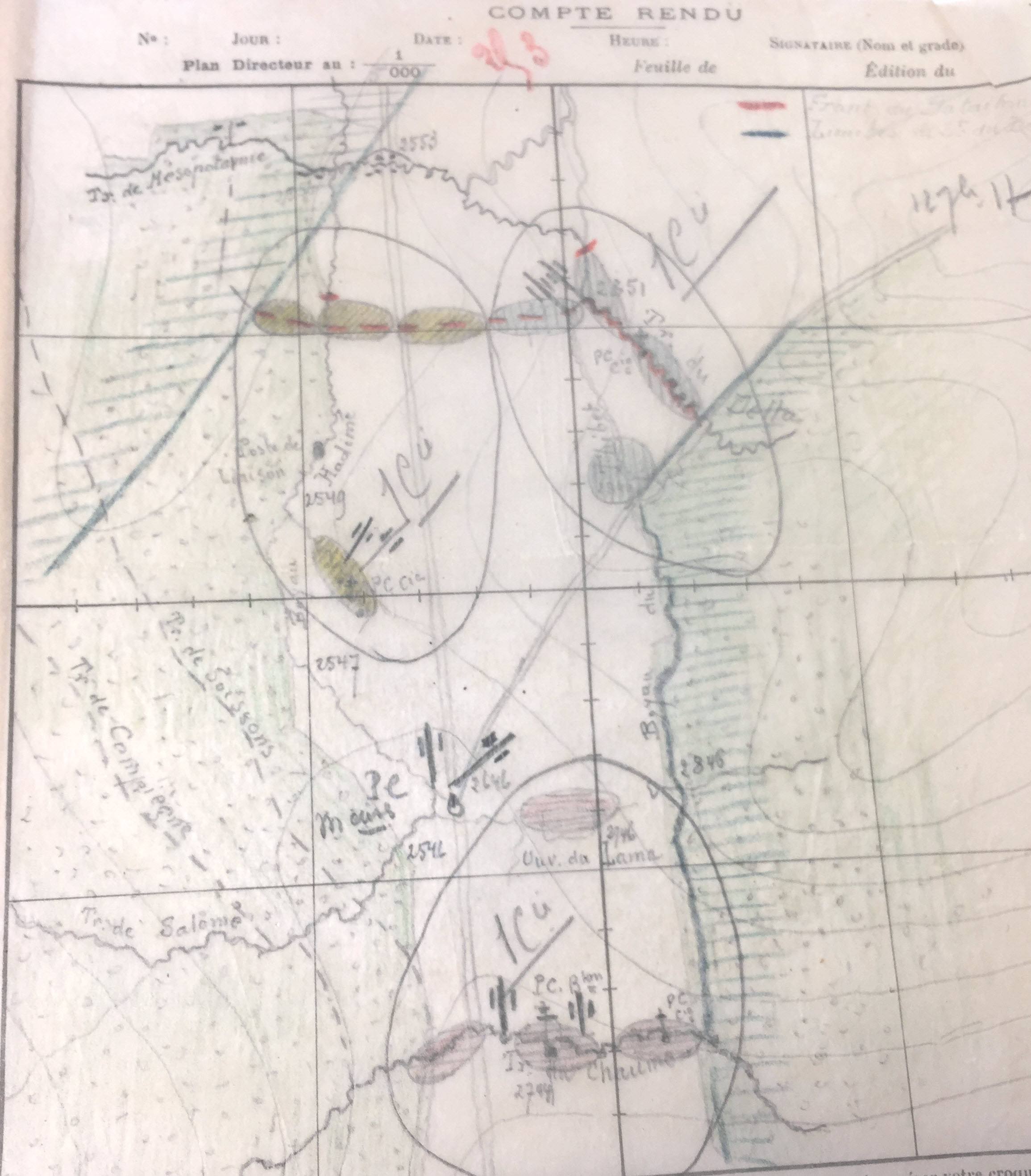

Sketches of 151 RI positions on 12 September 1917. (source: 151e RI regimental records)
Lieut. Xavier Lamothe de Mondion, KIA 10 Sept. 1917.
11-14 September: Situation unchanged. The units occupy the same positions. All day and night is spent deepening strengthening the conquered positions under heavy artillery fire. Losses for the regiment on 11 September include 17 wounded (incl. Capt. Garavel). This work continues the next day as the units transform the line of shell-holes into a new first-line trench. On the night of 12 Sept., 1 Bat/151 RI is relieved by two companies of the 348 RI. The 1 Bat. marches back to Faubourg-Pavé to rest. Losses for the regiment on 12 September include 1 killed and 12 wounded.
The German artillery bombardment continues to rage into the next day. On the night of 13 Sept., the 3 Bat/151 RI and left most elements of 2 Bat/151 RI are relieved by 4 Bat/348 RI. The 3 Bat. goes back to Faubourg-Pavé, while the relieved elements of 2 Bat. rest at the shelters of the Blaucharderie firing range. The 1 Bat. boards trucks and is driven to Vaucouleurs (Champangy-Septvigny). The 6 Co. and 2 MG Co. remain in line at the front. Losses for the regiment on 13 September include 6 wounded and 3 missing. According to the JMO, between 8-13 September the 151 had 71 confirmed killed, 393 wounded, and 162 missing. The f





